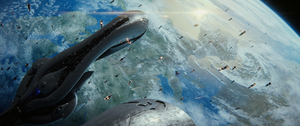Space warfare: Difference between revisions
From Halopedia, the Halo wiki
(I've put off the creation of this page for years now because of the sheer amount of content/sources needed, so I'm just going to release a rough sketch that can be filled out over time.) |
NightHammer (talk | contribs) No edit summary |
||
| Line 6: | Line 6: | ||
==History== | ==History== | ||
Space warfare evolved from engagements on a world's surface or in its atmosphere. With the invention of [[human]] space travel in the 20th century, many organizations and nations began to consider or invest in possible military operations conducted in space. In the late 21st century, humanity had become an interplanetary-faring species with colonies established in their [[Sol system|home system]]. The new outlet of travel and exploration would eventually lead to conflict.<ref>'''[[Halo Encyclopedia]]''', ''page 266'' (2011 edition)</ref> The dawn of the [[Interplanetary War]] and its associated engagements saw the formation of the [[United Nations Space Command]]'s [[UNSC Navy|Navy]] following the [[Mars Campaign]]. The campaign marked a turning-point in space warfare through dedicated utilizations of [[UNSC Marine Corps]] forces in ground assaults and ship-[[boarding]] operations that would follow during the war.<ref name="xbox">'''[[Xbox.com/Halo]]'''</ref> | |||
In the late 23rd century, humanity invented and began to utilize the [[Shaw-Fujikawa Translight Engine]] on their spacecraft, allowing human ships to travel through [[slipstream space]] to reach destinations light-years away.<ref>'''Halo Encyclopedia''', ''page 43'' (2011 edition)</ref> The UNSC Navy only conducted low-level operations, such as anti-[[piracy]] actions, until the [[Insurrection]], which forced the Navy to develop a modern space warfare doctrine. Following the [[Callisto Incident]] of [[2494]], the numerous small-scale space engagements occurred between the UNSC Navy and [[Insurrectionists]] across human space.<ref name="evolutions cole">'''Halo: Evolutions''', "The Impossible Life and the Possible Death of Preston J. Cole"</ref> | |||
{{Expand-section}} | {{Expand-section}} | ||
| Line 14: | Line 17: | ||
===Weaponry=== | ===Weaponry=== | ||
[[File:H4-Infinity-Firing.jpg|thumb|250px|{{UNSCShip|Infinity}} firing MAC rounds at ''[[Mantle's Approach]]''.]] | |||
[[Human]] starship weapons follow a similar trend as their ground armament and are largely based around ballistic impacts and chemical reactions. Meanwhile, Covenant weapons employ magnetically superheated [[plasma]] in their various weapon systems, a major contributor to their significant edge over the UNSC during the Human-Covenant War. | [[Human]] starship weapons follow a similar trend as their ground armament and are largely based around ballistic impacts and chemical reactions. Meanwhile, Covenant weapons employ magnetically superheated [[plasma]] in their various weapon systems, a major contributor to their significant edge over the UNSC during the Human-Covenant War. | ||
Revision as of 12:13, November 24, 2014
| This article does not have enough inline citations and/or does not adhere to the proper citation format. You can help Halopedia by adding citations. |

Space warfare is the conduct of conflict between belligerents in space. The scale of space warfare ranges from exoatmospheric fighter skirmishes and boarding actions to battles between fleets of warships, which often decide the outcome of a given engagement or conflict.
History
Space warfare evolved from engagements on a world's surface or in its atmosphere. With the invention of human space travel in the 20th century, many organizations and nations began to consider or invest in possible military operations conducted in space. In the late 21st century, humanity had become an interplanetary-faring species with colonies established in their home system. The new outlet of travel and exploration would eventually lead to conflict.[1] The dawn of the Interplanetary War and its associated engagements saw the formation of the United Nations Space Command's Navy following the Mars Campaign. The campaign marked a turning-point in space warfare through dedicated utilizations of UNSC Marine Corps forces in ground assaults and ship-boarding operations that would follow during the war.[2]
In the late 23rd century, humanity invented and began to utilize the Shaw-Fujikawa Translight Engine on their spacecraft, allowing human ships to travel through slipstream space to reach destinations light-years away.[3] The UNSC Navy only conducted low-level operations, such as anti-piracy actions, until the Insurrection, which forced the Navy to develop a modern space warfare doctrine. Following the Callisto Incident of 2494, the numerous small-scale space engagements occurred between the UNSC Navy and Insurrectionists across human space.[4]
 This section needs expansion. You can help Halopedia by expanding it.
This section needs expansion. You can help Halopedia by expanding it.
Technology
- Main articles: UNSC Navy, Covenant fleet, Forerunner fleet
As with warfare in general, the level of a given polity's technological advancement plays a considerable role in space engagements, and a technological edge can easily overcome superior tactics once the technological gap is substantial enough. During the Human-Covenant War, UNSC warships and weapon systems were decidedly inferior to their Covenant counterparts. This has changed in the post-war era with the introduction of new, more efficient technologies to UNSC Navy service as well as the Covenant's reduction into various smaller splinter groups with lessened access to the bleeding edge of Covenant technology.[5]
 This section needs expansion. You can help Halopedia by expanding it.
This section needs expansion. You can help Halopedia by expanding it.
Weaponry
Human starship weapons follow a similar trend as their ground armament and are largely based around ballistic impacts and chemical reactions. Meanwhile, Covenant weapons employ magnetically superheated plasma in their various weapon systems, a major contributor to their significant edge over the UNSC during the Human-Covenant War.
The heaviest weapon possessed by most UNSC warships is the Magnetic Accelerator Cannon, a spinal-mounted coilgun capable of accelerating metallic projectiles to prodigious velocities. The bulk of a vessel's offensive capability is comprised by missiles with conventionally explosive payloads, which are often deployed in large numbers; most warships carry a small amount of more powerful nuclear missiles as well. The most predominant type of conventional missile aboard UNSC Navy vessels is the Archer missile, while the Shiva and Hyperion are examples of the more sparsely deployed nuclear missiles. Close-in defense is provided by point-defense guns, large-caliber autocannons which are primarily used to intercept incoming fighters, boarding craft and munitions.
The primary armament of Covenant warships are a series of plasma turrets which use magnetic fields to shape and fire precision-guided globules of plasma—known as plasma torpedoes—easily capable of cutting through UNSC warships' battleplate. Most of their capital ships are also armed with one or more energy projectors, which fire a concentrated and highly precise beam of plasma and are used in both planetary glassing operations and ship-to-ship combat. Pulse laser turrets are used to provide point defense.
Defenses
UNSC warships use various forms of Titanium-A armor (an enhanced form of titanium) as their exterior battleplate. Covenant vessels are covered in nanolaminate hull plating, which is significantly stronger and more resilient. Most Covenant ships are also protected by energy shielding, which has seen limited adoption among UNSC Navy warships—including the Strident-class heavy frigates—in the post-war era.[5]
Both the UNSC and the Covenant are known to use dedicated space stations to defend their worlds. The UNSC's orbital defense platforms are anchored to a geosynchronous orbit and are armed with a powerful "super" MAC gun powered by a groundside generators. Covenant equivalents use versions of the energy projectors used on their warships.[6][7]
 This section needs expansion. You can help Halopedia by expanding it.
This section needs expansion. You can help Halopedia by expanding it.
Ship classes
 This section needs expansion. You can help Halopedia by expanding it.
This section needs expansion. You can help Halopedia by expanding it.
Strategy and tactics
The conduct of space warfare varies significantly between the Forerunners' height and the modern times due to the impact of the more advanced technologies employed in the former era in both strategic and tactical contexts.
Forerunner era
Space engagements carried out by Forerunners and their technologically equivalent contemporaries—most prominently ancient humans—were dazzlingly complex yet controlled affairs, involving seamless coordination across large distances as well as weapon systems and defenses extending through higher space-time branes.[8] These battles unfolded at speeds impossible for baseline individuals to follow[9] and often involved copious numbers of often automated attack craft, with each maneuver adjusted to fit the current tactical situation according to constantly shifting predictive calculations;[8] biological commanders could effectively contribute to these engagements due to sophisticated neurocognitive enhancement and mind-machine integration, enabling them to simultaneously perceive numerous differing viewpoints.[9][10] Individual Warriors would typically command up to a million weapon-ships during fleet engagements,[11] while the numbers of attack ships such as harriers could easily be in the hundreds of thousands.[8] In addition to physical weaponry, opposing ships also deployed weaponized AI systems and confinement fields against one another with the intent of eliminating the enemy vessel's capacity for resistance.[12] Higher-level combat skins such as war sphinxes blurred the line between infantry, aerial attack craft and space fighters and were used to a great effect in battles waged over planets.[13]
 This section needs expansion. You can help Halopedia by expanding it.
This section needs expansion. You can help Halopedia by expanding it.
Modern era
In the modern era, space battles are fought almost exclusively within the context of normal space-time, although precision slipspace jumps and faster velocities within the slipstream offer increased tactical maneuvering options as well as considerable strategic benefits. The vessels involved are typically directed by individuals with baseline reflexes delivering tactical commands verbally, placing certain upper limits on the speeds at which ships and fleets can respond to threats and changing tactical situations; under the control of an AI, a warship becomes far more combat-effective due to the constructs' significantly faster reactions and information processing capabilities.[14]
 This section needs expansion. You can help Halopedia by expanding it.
This section needs expansion. You can help Halopedia by expanding it.
List of appearances
Sources
- ^ Halo Encyclopedia, page 266 (2011 edition)
- ^ Xbox.com/Halo
- ^ Halo Encyclopedia, page 43 (2011 edition)
- ^ Halo: Evolutions, "The Impossible Life and the Possible Death of Preston J. Cole"
- ^ a b Halo 4: The Essential Visual Guide, page 192
- ^ Halo: Escalation, Issue #6
- ^ Halo Waypoint: Catalog Interaction (post 2994218)
- ^ a b c Halo: Silentium, pages 211-212
- ^ a b Halo: Cryptum, pages 161-162
- ^ Halo: Cryptum, page 316
- ^ Halo: Cryptum, page 174
- ^ Halo: Cryptum, pages 193-194
- ^ Halo: Cryptum, pages 66, 95, 163
- ^ Bungie.net: Jason Jones Interviewed By You (12/18/2001)
